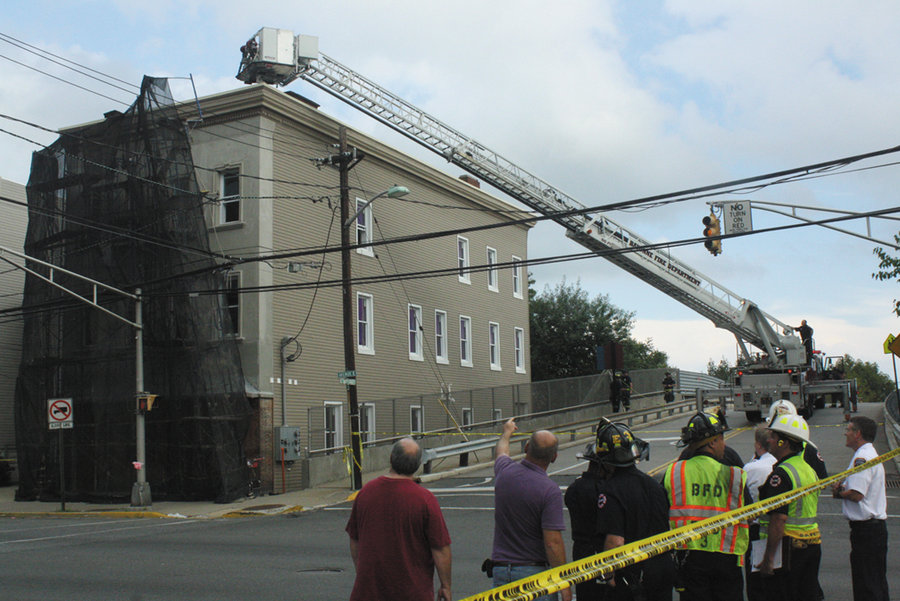Emergency workers could only wait and pray after three people called 911 on Sept. 29 to say that three floors of scaffolding installed at 424 Ave. E had come loose.
With streets closed over the 30th Street bridge and for a full block leading up to Bayonne Medical Center, emergency workers struggled to secure the top of the scaffolding as dark clouds and the rumble of thunder warned of an approaching storm.
“We were worried that the wind would blow the thing down,” said Fire Chief Greg Rogers, dressed in full rain gear as rain pelted at the workers. “Fortunately, the wind blew the scaffolding back against the building and we were able to secure it.”
The drama left a number of people stranded on the wrong side of the closed-off blocks, some of whom had cars that were parked nearby. Although many of the nearest cars were moved early during the incident, some people had to walk blocks to get to cars parked at Avenue E, while traffic on both sides of the bridge was diverted to other streets.
“We were lucky the wind blew it back against the building, but we had to be prepared for the worst.” – Greg Rogers
____________
The metal scaffolding rose to nearly the full length of the three-story building, and was in danger of collapsing onto the lines. Firefighters cordoned off the area with caution tape, and technical rope personnel began to prepare a lashing system to secure the scaffolding. The weather quickly changed, and dark clouds and wind rolled in. The steel scaffolding, already draped in construction tarp, started to sway and was pushed back against the building.
Firefighters, working from the interior, were able to quickly lash the scaffolding through the windows with rope before it could sway back out toward the power wires. PSE&G was called to the scene due to the electrical hazard, and reportedly called for an engineer to assess the scaffolding.
The Police Department, the Building Department, a representative of the federal Occupational Health and Safety Administration, and the building owner were called to the scene. There were no reported injuries, and there were no workers on the scaffolding when the fire department arrived.
On the scene, Rogers said while the scaffolding had been secured, it was still not safe until it was dismantled.
“We were lucky the wind blew it back against the building, but we had to be prepared for the worst,” Rogers said.
The big fear, he said, is that it would fall into the power lines and create an even more dangerous situation – especially after a significant downpour left puddles along the curb and other parts of the street.
Because of the expected high winds, the Fire Department was forced to lower their aerial platform that allowed firefighters easy access to the roof and an area that could approach the scaffolding from the top.
Inside the building, firefighters positioned themselves in several of the windows, using hand signals and radios to communicate with command personnel on the street below.
Police officers meanwhile had to turn back pedestrians who routinely cross the bridge after work. In one case, a woman walked down the street from one of the neighboring houses and directly under the leaning scaffolding, sending police officers scurrying in the rain to get her out of harm’s way.
Because the incident occurred near the beginning of rush hour, heavy traffic coming towards the bridge in all directions clogged other streets, such as Broadway and Prospect Avenue, for several hours. But city officials said the traffic was not as bad as many had expected.
Al Sullivan may be reached at asullivan@hudsonreporter.com.
